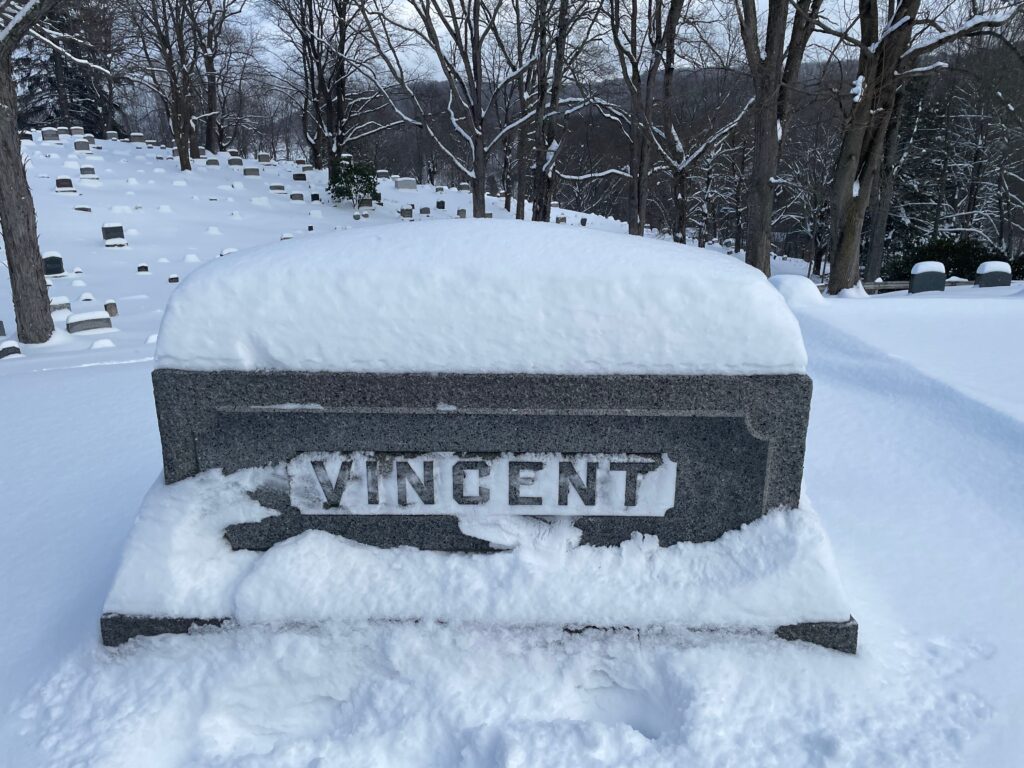Erik Visits an American Grave, Part 1,297
This is the grave of John Heyl Vincent.

Born in 1832 in Alabama, Vincent grew up and became a devout Methodist. I don’t know his relationship to slavery but he did leave the South soon after becoming a Methodist minister in 1850 and really never returned. The Methodist Church split over slavery in 1844 into regional churches. Perhaps Vincent felt more comfortable in the northern branch. In any case, I don’t see a lot of evidence either way on the point, so this is speculation.
Vincent rose fast in the Methodist church. He was named a church deacon in 1855 and became an Elder of the Rock River Conference. That put him in Illinois. He had a bunch of pastorates over the next several years, including in Galena, where he got to know Ulysses S. Grant. The future general and president wasn’t super religious and never had a church membership, but he would go to church sometimes and so they became friendly. He married a woman from New York and when the Civil War broke out, he did not return South. So that’s good. What he did do during the war was to go to Europe and Palestine. Again, I am not really sure if that trip was a way to sort of sit out the war. He obviously was of fighting age. But he was a lot more interested in teaching about the Bible than the war and wanted to see these places for himself.
Vincent’s real contribution, and the reason we are discussing him today, is that he founded the Chautauqua Institution in 1874. He did this to train Sunday School teachers. He had been committed to the training of these teachers since 1866 and so he moved to Chautauqua in 1872 to work with the industrialist Lewis Miller on the project. Vincent’s obsession in teaching this was the geography of the Holy Land. That was his justification in visiting there and he basically wanted to create something of a theme park recreating Palestine in western New York. Not exactly a very good geographical match, nor do I know what visualized Palestine would really mean in terms of teaching the Bible, but whatever.
Of course, the Chautauqua has moved far beyond these initial origins. It became a huge driver of mildly reform-based teaching and arts education on a wide variety issues. It always has included religion as one of its interests, but it soon went far, far beyond Vincent’s vision. I don’t exactly know what Vincent thought about this, but I know Miller was for it. Miller’s wife in fact married Thomas Edison and became known for spreading the Chautauqua ideal around the nation. Its heyday was between the late nineteenth and mid twentieth centuries I do think Vincent was for it though. He thought of education as the real secret of life. Moreover, he knew that the vast majority of Americans, even the really curious and smart ones, could never access higher education. So learning philosophy and history, as well as religion, was something he wanted to emphasize.
Vincent had the real ticket to making Chautauqua popular–his old buddy Grant. The president visited Chautauqua in 1875 and it became a national story. 15,000 people met the nation’s most popular man in that little town. It was at Chautauqua where the first ever Book of the Month Club developed. He also helped deliver a first rate concert hall for the locals and visitors.
In 1888, Vincent moved to Buffalo as a bishop of the Methodist Church. That kept him fairly close to Chautauqua. He also had a guest bishopric deal in Zurich in 1904. In fact, he spent a lot of years in Europe over time, doing a lot of traveling back and forth and promoting his ideas. He also became a supporter of women’s rights, including in the Methodist church. He published his memoirs in 1910 and died in 1920. He was 88 years old.
John Heyl Vincent is buried in Chestnut Hill Cemetery, Portville, New York.
If you would like this series to visit other educational figures in American history, you can donate to cover the required expenses here. William Holmes McGuffey is in Charlottesville, Virginia and Henry Martin Tupper is in Raleigh, North Carolina. Previous posts in this series are archived here.


